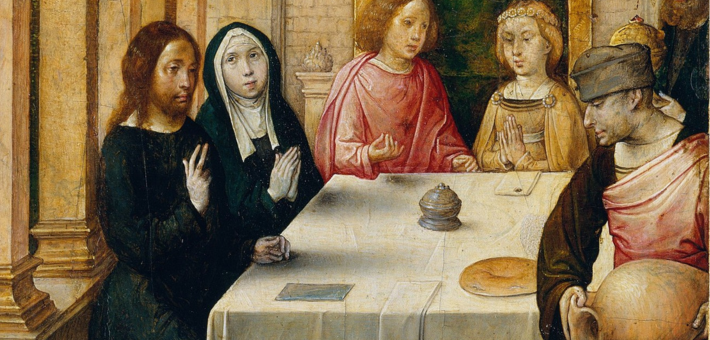Commentary on John 2:1-11
At the end of John 1, Jesus promised Nathanael (and by extension his other disciples as well) that he would see “greater things.” It doesn’t take long for us to find out at least the start of what that means. Chapter 2 begins with a common and joyful event: a wedding. It is a rather odd wedding story since the focus is not on the happy couple. The bride is never mentioned, and the groom makes only a brief appearance with no spoken part at all (verse 9).
Questions abound: Are they friends of Jesus and his family? Are they relatives? Why does Jesus’ mother think he can do something about the wine running out? Is this simply a matter of social obligation for the guests (or the members of the extended family) to help provide for the wedding celebration, or does his mother expect something “greater”? If so, why would she expect such things? Within John, she has not been mentioned at all before this story, so we should be cautious about assuming details regarding Jesus’ conception and birth from Matthew and Luke to fill in the gaps here. There is ambiguity in her request.
And what of Jesus’ response to her? His “hour” has not yet come, meaning his hour of glorification that will come with his crucifixion (see 12:20–25). Yet Jesus does not abandon the wedding party to their empty wine bottles. In this Gospel Jesus has a habit of first refusing and then fulfilling requests. At the start of chapter 7 Jesus tells his brothers that he will not go to Jerusalem, but then he goes “in secret.” At the start of chapter 11 Mary and Martha implicitly ask Jesus to come and heal Lazarus (or at least come to be with them during this difficult time), but he waits for two days before leaving for their home.
In our text, too, Jesus seems to resist the request of his mother before addressing the situation. In this pattern of behavior, Jesus distances himself from any kind of authority his family or friends might assume over him. What Jesus does is not due to social or familial pressure. This pattern makes clear that what Jesus does is a matter of grace.
The grace that Jesus shows in this scene is an act of overflowing abundance. Though we don’t know how many guests were at this wedding celebration, we might reasonably assume that 120 gallons of additional wine after the guests have had a good deal to drink already (verse 10) was more than enough. The setting of a wedding already engages the imagination of careful readers. It is an event that points to deep relational bonds, intimate connections, and the establishing of family. Such intimacy will be echoed within John’s Gospel as Jesus talks about how the disciples and he will “abide” in each other and how the disciples will “abide” in his love (15:4, 9–10).
Jesus addresses his mother as “woman” again from the cross, when he creates a new familial relationship between the “beloved disciple” and his own mother (19:26–27). Further, the wedding is a rich image in Jewish tradition, pointing to the time of God’s deliverance and blessing for Israel (Isaiah 61:10; see also Revelation 19:7–9; 21:2).
Wine in abundance is part of how that promised day of celebration is imagined (Joel 3:18; Isaiah 25:6). Second Baruch 29:5 (probably written, like John, near the end of the first century) promises that “on one vine will be a thousand branches, and one branch will produce a thousand clusters, and one cluster will produce a thousand grapes, and one grape will produce a cor [with some historical uncertainty, about 50 gallons] of wine.”
For all the bells of the messianic age that this story may ring for readers, the act of Jesus is surprisingly underplayed. There is no recounting of Jesus placing his hands over the jars of water and praying for a transformation into wine. The change is mentioned almost in passing in verse 9, so that it may even surprise the first-time reader. It is a striking de-centering of the “miracle.” The result is not that the wedding is filled with marveling crowds but that the disciples believe in Jesus (verse 11). The event has become, for them, the first “sign,” a revelation of Jesus’ glory. This glory is not simply equated with the power to do miracles. Rather, as a sign this event points beyond itself to the deeper reality of just who Jesus is.
Yet the relationship between “sign” and “faith” in John’s Gospel is not simple. Here, it may seem rather straightforward: The disciples witness the sign and it leads to faith. Yet at the end of chapter 2 there is some hesitation about those who believe because they have seen signs (2:23–25). Seeing the signs does not automatically lead to believing at all (12:37–41). At the wedding, in some mysterious way it seems that properly seeing the sign also requires faith. The servants know where the wine has come from, yet they apparently do not see the glory of Jesus in this event; they are not explicitly said to believe. The glory remains hidden from most at the wedding.
It will not be difficult for preachers to find examples of where our resources run short, intruding even into what should be joyous times of life: Shortfalls in finances, health, patience, compassion, and hope can all threaten to empty the celebration. What then is the “glory” that we see revealed? As in this story, we may find that the flashy miraculous is underplayed and hidden. Yet the glory of Christ is revealed in love, in service, in community, in grace. There is no transfiguration story in John. Instead, Jesus’ glory is seen all through his ministry and is especially revealed as he is glorified in his death and resurrection.1 There the wine overflows for us too.
Notes
- Gail R. O’Day, “The Gospel of John,” in The New Interpreter’s Bible, vol. 9 (Nashville: Abingdon, 1995), 539.


January 19, 2025